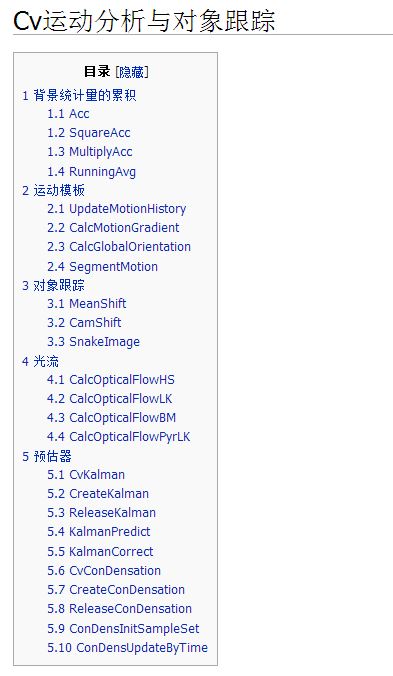http://wiki.opencv.org.cn/index.php/Cv运动分析与对象跟踪
http://wiki.opencv.org.cn/index.php/增强现实%28AR%29
opencv2中的segmentMotion内部调用的还是cvSegmentMotion这个函数。
void cv::segmentMotion(InputArray _mhi, OutputArray _segmask,
vector<Rect>& boundingRects,
double timestamp, double segThresh)
{
Mat mhi = _mhi.getMat();
_segmask.create(mhi.size(), CV_32F);
CvMat c_mhi = mhi, c_segmask = _segmask.getMat();
Ptr<CvMemStorage> storage = cvCreateMemStorage();
Seq<CvConnectedComp> comps = cvSegmentMotion(&c_mhi, &c_segmask, storage, timestamp, segThresh);
Seq<CvConnectedComp>::const_iterator it(comps);
size_t i, ncomps = comps.size();
boundingRects.resize(ncomps);
for( i = 0; i < ncomps; i++, ++it)
boundingRects[i] = (*it).rect;
}
CvSeq* cvSegmentMotion( const CvArr* mhi, CvArr* seg_mask, CvMemStorage* storage,
double timestamp, double seg_thresh );
mhi 运动历史图像
seg_mask 发现应当存储的 mask 的图像, 单通道, 32bits, 浮点数.
storage 包含运动连通域序列的内存存储仓
timestamp 当前时间,毫秒单位
seg_thresh 分割阈值,推荐等于或大于运动历史“每步”之间的间隔。
函数 cvSegmentMotion 寻找所有的运动分割,并且在seg_mask 用不同的单独数字(1,2,...)标识它们。
它也返回一个具有 CvConnectedComp 结构的序列,其中每个结构对应一个运动部件。
在这之后,每个运动部件的运动方向就可以被函数 cvCalcGlobalOrientation 利用提取的特定部件的掩模(mask)计算出来(使用 cvCmp)
(1)cvSegmentMotion示例代码
#include "stdafx.h"
#include "opencv2/video/tracking.hpp"
#include "opencv2/highgui/highgui.hpp"
#include "opencv2/imgproc/imgproc_c.h"
#include <time.h>
#include <stdio.h>
#include <ctype.h>
static void help(void)
{
printf(
"\nThis program demonstrated the use of motion templates -- basically using the gradients\n"
"of thresholded layers of decaying frame differencing. New movements are stamped on top with floating system\n"
"time code and motions too old are thresholded away. This is the 'motion history file'. The program reads from the camera of your choice or from\n"
"a file. Gradients of motion history are used to detect direction of motoin etc\n"
"Usage :\n"
"./motempl [camera number 0-n or file name, default is camera 0]\n"
);
}
// various tracking parameters (in seconds)
const double MHI_DURATION = 1;
const double MAX_TIME_DELTA = 0.5;
const double MIN_TIME_DELTA = 0.05;
// number of cyclic frame buffer used for motion detection
// (should, probably, depend on FPS)
const int N = 4;
// ring image buffer
IplImage **buf = 0;
int last = 0;
// temporary images
IplImage *mhi = 0; // MHI
IplImage *orient = 0; // orientation
IplImage *mask = 0; // valid orientation mask
IplImage *segmask = 0; // motion segmentation map
CvMemStorage* storage = 0; // temporary storage
// parameters:
// img - input video frame
// dst - resultant motion picture
// args - optional parameters
static void update_mhi( IplImage* img, IplImage* dst, int diff_threshold )
{
double timestamp = (double)clock()/CLOCKS_PER_SEC; // get current time in seconds
CvSize size = cvSize(img->width,img->height); // get current frame size
int i, idx1 = last, idx2;
IplImage* silh;
CvSeq* seq;
CvRect comp_rect;
double count;
double angle;
CvPoint center;
double magnitude;
CvScalar color;
// allocate images at the beginning or
// reallocate them if the frame size is changed
if( !mhi || mhi->width != size.width || mhi->height != size.height ) {
if( buf == 0 ) {
buf = (IplImage**)malloc(N*sizeof(buf[0]));
memset( buf, 0, N*sizeof(buf[0]));
}
for( i = 0; i < N; i++ ) {
cvReleaseImage( &buf[i] );
buf[i] = cvCreateImage( size, IPL_DEPTH_8U, 1 );
cvZero( buf[i] );
}
cvReleaseImage( &mhi );
cvReleaseImage( &orient );
cvReleaseImage( &segmask );
cvReleaseImage( &mask );
mhi = cvCreateImage( size, IPL_DEPTH_32F, 1 );
cvZero( mhi ); // clear MHI at the beginning
orient = cvCreateImage( size, IPL_DEPTH_32F, 1 );
segmask = cvCreateImage( size, IPL_DEPTH_32F, 1 );
mask = cvCreateImage( size, IPL_DEPTH_8U, 1 );
}
cvCvtColor( img, buf[last], CV_BGR2GRAY ); // convert frame to grayscale
idx2 = (last + 1) % N; // index of (last - (N-1))th frame
last = idx2;
silh = buf[idx2];
cvAbsDiff( buf[idx1], buf[idx2], silh ); // get difference between frames
cvThreshold( silh, silh, diff_threshold, 1, CV_THRESH_BINARY ); // and threshold it
cvUpdateMotionHistory( silh, mhi, timestamp, MHI_DURATION ); // update MHI
// convert MHI to blue 8u image
cvCvtScale( mhi, mask, 255./MHI_DURATION,
(MHI_DURATION - timestamp)*255./MHI_DURATION );
cvZero( dst );
cvMerge( mask, 0, 0, 0, dst );
// calculate motion gradient orientation and valid orientation mask
cvCalcMotionGradient( mhi, mask, orient, MAX_TIME_DELTA, MIN_TIME_DELTA, 3 );
if( !storage )
storage = cvCreateMemStorage(0);
else
cvClearMemStorage(storage);
// segment motion: get sequence of motion components
// segmask is marked motion components map. It is not used further
seq = cvSegmentMotion( mhi, segmask, storage, timestamp, MAX_TIME_DELTA );
// iterate through the motion components,
// One more iteration (i == -1) corresponds to the whole image (global motion)
for( i = -1; i < seq->total; i++ ) {
if( i < 0 ) { // case of the whole image
comp_rect = cvRect( 0, 0, size.width, size.height );
color = CV_RGB(255,255,255);
magnitude = 100;
}
else { // i-th motion component
comp_rect = ((CvConnectedComp*)cvGetSeqElem( seq, i ))->rect;
if( comp_rect.width + comp_rect.height < 100 ) // reject very small components
continue;
color = CV_RGB(255,0,0);
magnitude = 30;
}
// select component ROI
cvSetImageROI( silh, comp_rect );
cvSetImageROI( mhi, comp_rect );
cvSetImageROI( orient, comp_rect );
cvSetImageROI( mask, comp_rect );
// calculate orientation
angle = cvCalcGlobalOrientation( orient, mask, mhi, timestamp, MHI_DURATION);
angle = 360.0 - angle; // adjust for images with top-left origin
count = cvNorm( silh, 0, CV_L1, 0 ); // calculate number of points within silhouette ROI
cvResetImageROI( mhi );
cvResetImageROI( orient );
cvResetImageROI( mask );
cvResetImageROI( silh );
// check for the case of little motion
if( count < comp_rect.width*comp_rect.height * 0.05 )
continue;
// draw a clock with arrow indicating the direction
center = cvPoint( (comp_rect.x + comp_rect.width/2),
(comp_rect.y + comp_rect.height/2) );
cvCircle( dst, center, cvRound(magnitude*1.2), color, 3, CV_AA, 0 );
cvLine( dst, center, cvPoint( cvRound( center.x + magnitude*cos(angle*CV_PI/180)),
cvRound( center.y - magnitude*sin(angle*CV_PI/180))), color, 3, CV_AA, 0 );
}
}
int main(int argc, char** argv)
{
IplImage* motion = 0;
CvCapture* capture = 0;
help();
// if( argc == 1 || (argc == 2 && strlen(argv[1]) == 1 && isdigit(argv[1][0])))
// capture = cvCaptureFromCAM( argc == 2 ? argv[1][0] - '0' : 0 );
// else if( argc == 2 )
// capture = cvCaptureFromFile( argv[1] );
capture = cvCaptureFromCAM( 0 );
if( capture )
{
cvNamedWindow( "Motion", 1 );
for(;;)
{
IplImage* image = cvQueryFrame( capture );
if( !image )
break;
if( !motion )
{
motion = cvCreateImage( cvSize(image->width,image->height), 8, 3 );
cvZero( motion );
motion->origin = image->origin;
}
update_mhi( image, motion, 30 );
cvShowImage( "Motion", motion );
if( cvWaitKey(10) >= 0 )
break;
}
cvReleaseCapture( &capture );
cvDestroyWindow( "Motion" );
}
return 0;
}
#ifdef _EiC
main(1,"motempl.c");
#endif
(2)测试效果

